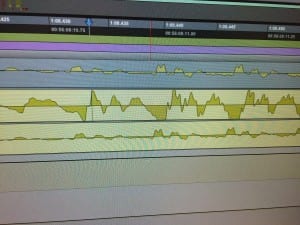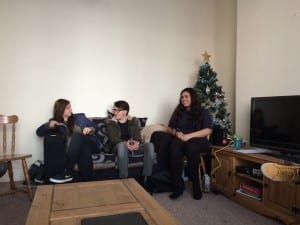Semester B – Audio Project 2 Group Members
Alice Asbury – aliceasbaudioproject2.blogs.lincoln.ac.uk
Gareth Bailey – gbaup3semb.blogs.lincoln.ac.uk
Anthony Belcher – ap2anthony.blogs.lincoln.ac.uk
Rory Hunter – roryhunteraudio.blogs.lincoln.ac.uk
Matthew Jones – aptwo.blogs.lincoln.ac.uk
Project Overview
The students will collaborate to provide audio services ranging from location recording, post-production sound design / mixing and music composition to five films as a research exercise focussed on managing and completing multiple projects in an appropriate way.
The five films consist of two 15 – 20 minute short films, one 10 – 12 minute short film, one 4 – 6 minute short film and one 3 – 4 minute animation. The films are detailed below along with the relevant group member designated as it’s project manager. This person will act as main point of contact for their designated director / producer, will direct the overall sound design of the piece, and will manage the allocation of resources to the project.
The entire group are jointly responsible for the final quality (with reference to individual and collaborative contributions to the soundtrack of the films) and delivery (with reference to individual and collective contributions to the day to day running of the Omni-Gaffer Productions ‘business’) of all five films as one artifact.
Film Synopsis and Details
Remember – Garden Gnome Films
Dilpret Rall – Director/Producer/Editor
Olivia Thompson – Camera/Producer/Editor
Client Sound Requirements: location sound recording, music composition, post-production sound design/mixing.
Synopsis (15 – 20 minutes):
Remember is a film that tells the story of a man’s life told by his family and friends. Arthur is a strong and caring man who is tragically put into a coma after an accident. In hospital he is visited by his friends and family, they share stories around the bed and paint a vivid picture of his amazing life.
Audio Project Manager: Anthony Belcher – ap2anthony.blogs.lincoln.ac.uk
Feel Good – Big Blue Bear Productions
Fiona Shaw – Producer
Thomas Love – Director/Writer
David Devine – Writer/Location Sound
Kane Brookes – Cinematographer
Client Sound Requirements: music composition, post-production sound design/mixing.
Synopsis (15 – 20 minutes):
Feel Good is set in a near future where a ground breaking discovery has made it possible to bottle and market emotions.
Audio Project Manager: Alice Asbury
Descent – Extant Films
Shaun Standring – Producer/Writer
Angelin Selvanathan – Director
Charlotte Hughes – Art Director
Client Sound Requirements: location sound recording, music composition, post-production sound design/mixing.
Synopsis (10 – 12 minutes):
A short psychological drama which mainly follows one character as he goes about his life inconspicuously, however, it soon turns out he has underlying issues that come to the surface as the plot thickens.
Audio Project Manager: Gareth Bailey
Immort – dir. Jacob Redfern
Holly Oakes – Producer
Jacob Redfern – Director/Writer/Editor
Nicholas Thornthwaite – Cinematographer
Samantha Dos Santos – VFX Artist
Lyon Owen – VFX Artist
James Smillie – VFX Artist
Client Sound Requirements: location sound recording, music composition, post-production sound design/mixing.
Synopsis (4 – 6 minutes):
Immort, is a sci-fi short film with the dystopian theme of humanity being immortal due to the public distribution of nanobots. The protagonist Sici is dissatisfied with how little control she has over her fully automated life. Through technological experimentation, Sici makes an attempt to end her life. The film questions the purpose of living when you can never die.
Audio Project Manager: Matthew Jones
Catastrophe/Sour Puss – Team Cipher
Esther Langan – Animator
Holly Burch – Animator
Jameela Howard – Animator
Konstantinos Zacharakis – Animator
Natalie O’Connell – Animator
Client Sound Requirements: music composition, sound design/mixing.
Synopsis (3 – 4 minute animation):
Starts with a shot of a cat waking up to the sound of a doorbell. It watches its owner walk to the door, receive a package, then walk into the kitchen. The cat follows her in; where there is a bowl bad tasting cat food is waiting for him. He looks dissatisfied and watches as his owner opens a cupboard and stretches for something at the back of the top shelf. A bowling ball (that is on the top shelf) with a little paw print on it starts to roll down and hits the owner on the head, knocking her out. As she lies on the floor, the cat stares at her stoically. It cuts to the cat washing his paws, then walking upstairs, to the owner’s bedroom. He dresses up as his owner and essentially takes her place.
Audio Project Manager: Rory Hunter

Group Aim
To manage the process of creating the above soundtracks collectively, and to deliver these soundtracks to a good standard and to the client’s specifications.
Group Objectives
- [GR1] To professionally operate as a small to medium size company (or other recognisable business entity) in the audio production / post-production field might.
- [GR2] To organise and fulfil an operating strategy and schedule which deals with multiple productions simultaneously, and which maximises efficiency and minimises issues or risks to delivery.
- [GR3] To provide a professional standard of service in respect to location sound recording and post-sound design / mixing.
- [GR4] To conceive, compose, source and / or produce music to client specifications that synergistically supports the other components of their films.
- [GR5] To produce soundtracks comprising of foley, SFX, dialogue, music and atmospheres to client specifications that synergistically support the other components of their films.
Outcomes and Learning in the context of Moving Picture Industry roles
- [IN1] To successfully manage the provision of service by the business for the film Descent with regard the assignment of resources, specialisms and working time, liason with the director, editor and producer on a practical and creative level, and communication of information on their needs and requirements for the piece, in order to appraise the efficacy of the collaborative approach to working on the piece – (Supervisor and Company Officer)
- [IN2] To develop a better understanding of the craft and industry of a Dubbing Mixer, and to contribute to the dub mixing required for presentation of the artifact – (Dubbing Mixer)
- [IN3] To better my understanding of sound design with at least some reference to the science fiction genre – (Sound Effects Editor)
Personal Learning Outcomes
- [PER1] To develop a better understanding of the pros and cons of business structures, processes, regulations and agreements which might enable film audio producers to collaborate on multiple projects.
- [PER2] To develop a better understanding of the wording and content of contracts, rates and rate cards offered in the film audio field.
- [PER3] To expand my knowledge of the theory of and audio techniques deployed in films similar to or influential upon those we will deliver.
- [PER4] To contribute extensively to multiple film productions.

